The ecology of faith
In a recent blog, Archbishop Thomas Gullickson, Nuncio of the Holy See to Ukraine, takes issue with Sherry Weddell’s book on discipleship in the Catholic Church (“A Personal Relationship with Christ?”). He defends the importance of the “Volkskirche,” or “cultural Catholicism,” which should not be abandoned in favor of a purely personal religion.
Ukrainian Greek-Catholics would no doubt agree. Whatever the virtues of the Protestant emphasis on a “personal relationship with Christ,” it is no substitute for the collective spirituality of the Volkskirche. And while Ms. Weddell may be right about the demise of American “cultural Catholicism” as a whole, the Ukrainian Church is firmly rooted in its culture, both in the homeland and the diaspora.
To be sure, this phenomenon, in its peculiarly Ukrainian form, has its dangers. All too often, Ukrainian religiosity (both Catholic and Orthodox) is reduced to a complex of folk customs and rituals. This was one consequence of Soviet official atheism, but it has also occurred in the secularized West. Such “folkloric religion” has broad appeal, and can lead many to a mature faith. Yet it can also degenerate to mere superstition. Moreover, the moral and ethical aspects of the faith are sometimes left behind, while theological knowledge is abandoned. By itself, this kind of traditional cultural Catholicism cannot survive modernity, except as a holiday entertainment.
Yet there is another kind of “folk religion” that is a powerful force in much of what used to be called the Third World. This is the contemporary popularChristian culture expressed in charismatic, Pentecostal, and evangelical movements. The purging of folk culture from the Catholic Church was no doubt justified in past centuries. But it may have resulted in the loss of many Latin American and African souls to unstructured, highly emotional popular forms of religious culture more attractive than the solemnities of formal processions or Gregorian chant. Some Catholic parishes in Latin America and the United States have adopted these contemporary cultural forms. (We should not confuse this with the lame attempts of some North American parishes to attract youth by recycling 1960s and 1970s pop music in religious garb.) The tradition-bound Ukrainian Greek-Catholic Church has not attempted anything like this, and indeed, it is highly unlikely to do so.
There is, however, yet another aspect of culture that Catholics of both the Latin and the various Eastern traditions should also treasure. It is the “high culture” of their past. For Latin Catholics, it is the heritage of theologians like Saint Thomas Aquinas; of literary figures from Dante to moderns like Chesterton, T.S. Eliot, Graham Greene or Flannery O’Connor; of painters, sculptors, and architects from antiquity to the present; of composers from Palestrina to Poulenc. Much of this culture used to be passed on in Catholic schools and colleges, but it is also transmitted in the better secular universities, for example in “Great Books” or “Western Civilization” courses or “core curricula.”But this is not enough. Adequate cultural nourishment requires contact with contemporary Roman Catholic high culture – the works of living philosophers or public intellectuals like George Weigel, and of the writers, painters, sculptors, and composers who work within that tradition.
What would constitute traditional “high culture” for Ukrainian Catholics? It would surely include the Eastern Fathers of the Church (even if the distinction between “Eastern” and “Western” doesn’t always make sense in this context), as well as East Slavic theologians like MeletyiSmotryts’kyi – who initially opposed the Union of Brest, but became its foremost defender. Most of Ukraine’s theological and cultural achievements, however, occurred in the Orthodox camp, and were appropriated by the Russian Church. Hence, constructing a Ukrainian Catholic theological and cultural tradition is problematic. There were certainly thinkers whose works harmonize with, and enrich, the “Byzantine-Kyivan Catholic” tradition, even if they opposed the Union of Brest. Orthodox Metropolitan Peter Mohyla, for example, was no enemy of Western, even Latin learning. But it would be incongruous to include in that tradition those whose thinking was decidedly anti-Catholic, even if they are worth studying for other reasons. Here one would include those who have seen Western European culture as intrinsically evil and incompatible with true Christianity.
In the late modern age -- aside from the mostly anonymous creators of icons and churches, and some highly creative priest-composers -- the literary and artistic intelligentsia of Greek-Catholic western Ukraine were largely secular in outlook. As for contemporary high culture, there are, of course, theologians like the Patriarch emeritus LubomyrHusar. But outside the Church, one can only point to the occasional Catholic poet like IhorKalynets’, and a few painters, iconographers, composers, and church architects; the former dissident MyroslavMarynovych is practically the only Ukrainian Catholic public intellectual (much as YevhenSverstiuk is practically the only one on the Orthodox side).
A “personal relationship with Christ” is a fine thing. But in the ecology of faith, it needs the nourishment of a cultural matrix. The ideal cultural matrix comprises four elements -- traditional folk religion, contemporary popular religion, traditional high culture, and contemporary high culture. If Americans are losing the first and are weak on the second, they are still rich in the third element, though a higher profile would benefit their achievements in the fourth. Ukrainian Greek-Catholics (like their Orthodox brethren) have plenty of traditional folk religion but no real contemporary popular Christian culture; wealthy in traditional high culture, they have much work to do to build a contemporary one.










